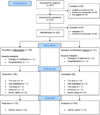Automated monitoring of symptoms during ambulatory chemotherapy and oncology providers' use of the information: a randomized controlled clinical trial
- PMID: 24687538
- PMCID: PMC4290846
- DOI: 10.1007/s00520-014-2216-1
Automated monitoring of symptoms during ambulatory chemotherapy and oncology providers' use of the information: a randomized controlled clinical trial
Abstract
Purpose: Monitoring patient-reported symptoms is necessary to adjust and improve supportive care during chemotherapy. Continuing advances in computerized approaches to symptom monitoring can enhance communication about unrelieved symptoms between patients and oncology providers and may facilitate intensified symptom treatment.
Methods: An automated IT-based telephone monitoring system was developed to enable oncology providers to receive and act on alert reports from patients about unrelieved symptoms during chemotherapy treatment. Daily, 250 participants (randomized to treatment or attentional control) were asked to call the automated system to report presence, severity, and distress for common chemotherapy-related symptoms (1-10 scale if present). For the treatment group, symptoms exceeding preset thresholds for moderate-to-severe intensity levels generated emailed alert reports to both the patient's oncologist and oncology nurse.
Results: Patients reported high satisfaction and ease of use of the automated system. Over 80 % of providers reported usefulness of the symptom alert reports. Ten monitored symptoms resulted in, on average, nine moderate-to-severe intensity alerts per patient over 45 study days. However, providers rarely contacted patients after receiving alerts. There were no significant differences in change of symptom severity between the two groups (mean difference = 0.06, p = 0.58).
Conclusion: Despite patients' use of a daily symptom monitoring system and providers' receipt of information about unrelieved symptoms of moderate-to-severe intensity, oncology physicians and nurses did not contact patients to intensify symptom treatment nor did symptoms improve. Further research is indicated to determine if oncology providers initiated follow-up to intensify symptom treatment, whether symptom outcomes would improve.
Conflict of interest statement
Similar articles
-
Automated home monitoring and management of patient-reported symptoms during chemotherapy: results of the symptom care at home RCT.Cancer Med. 2017 Mar;6(3):537-546. doi: 10.1002/cam4.1002. Epub 2017 Jan 30. Cancer Med. 2017. PMID: 28135050 Free PMC article. Clinical Trial.
-
Automated symptom alerts reduce postoperative symptom severity after cancer surgery: a randomized controlled clinical trial.J Clin Oncol. 2011 Mar 10;29(8):994-1000. doi: 10.1200/JCO.2010.29.8315. Epub 2011 Jan 31. J Clin Oncol. 2011. PMID: 21282546 Free PMC article. Clinical Trial.
-
Chemotherapy-related neuropathic symptom management: a randomized trial of an automated symptom-monitoring system paired with nurse practitioner follow-up.Support Care Cancer. 2018 May;26(5):1607-1615. doi: 10.1007/s00520-017-3970-7. Epub 2017 Dec 5. Support Care Cancer. 2018. PMID: 29204710 Clinical Trial.
-
Telephone interventions for symptom management in adults with cancer.Cochrane Database Syst Rev. 2020 Jun 2;6(6):CD007568. doi: 10.1002/14651858.CD007568.pub2. Cochrane Database Syst Rev. 2020. PMID: 32483832 Free PMC article.
-
Electronic patient-reported outcome systems in oncology clinical practice.CA Cancer J Clin. 2012 Sep-Oct;62(5):337-47. doi: 10.3322/caac.21150. Epub 2012 Jul 18. CA Cancer J Clin. 2012. PMID: 22811342 Review.
Cited by
-
Feasibility randomised controlled trial of remote symptom chemotherapy toxicity monitoring using the Canadian adapted Advanced Symptom Management System (ASyMS-Can): a study protocol.BMJ Open. 2020 Jun 17;10(6):e035648. doi: 10.1136/bmjopen-2019-035648. BMJ Open. 2020. PMID: 32554724 Free PMC article.
-
Differential Effects of a Telemonitoring Platform in the Development of Chemotherapy-Associated Toxicity: A Randomized Trial Protocol.Diagnostics (Basel). 2024 Mar 14;14(6):619. doi: 10.3390/diagnostics14060619. Diagnostics (Basel). 2024. PMID: 38535039 Free PMC article.
-
Intensive Longitudinal Methods Among Adults With Breast or Lung Cancer: Scoping Review.J Med Internet Res. 2024 Jun 12;26:e50224. doi: 10.2196/50224. J Med Internet Res. 2024. PMID: 38865186 Free PMC article.
-
Cancer Care Delivery Research: Building the Evidence Base to Support Practice Change in Community Oncology.J Clin Oncol. 2015 Aug 20;33(24):2705-11. doi: 10.1200/JCO.2014.60.6210. Epub 2015 Jul 20. J Clin Oncol. 2015. PMID: 26195715 Free PMC article.
-
Symptom Trajectories Are Associated With Co-occurring Symptoms During Chemotherapy for Breast Cancer.J Pain Symptom Manage. 2019 Feb;57(2):183-189. doi: 10.1016/j.jpainsymman.2018.11.010. Epub 2018 Nov 17. J Pain Symptom Manage. 2019. PMID: 30453052 Free PMC article.
References
-
- Atherton P, Sloan J. Rising importance of patient-reported outcomes. Lancet Oncol. 2006;7(11):883–884. - PubMed
-
- Basch E, Abernethy A. Supporting clinical practice decisions with real-time patient-reported outcomes. J Clin Oncol. 2011;29(8):954–956. - PubMed
-
- Bren L. The importance of patient-reported outcomes. It’s all about the patients. FDA Consum. 2006;40(6):26–33. - PubMed
-
- Grenhalgh J. The applications of PROs in clinical practice: what are they, do they work, and why? Qual Life Res. 2009;18(1):115–123. - PubMed
-
- Trotti A, et al. Patient-reported outcomes and the evolution of adverse event reporting in oncology. J Clin Oncol. 2007;25(32):5121–5127. - PubMed
Publication types
MeSH terms
Substances
Grants and funding
LinkOut - more resources
Full Text Sources
Other Literature Sources
Medical
Miscellaneous


